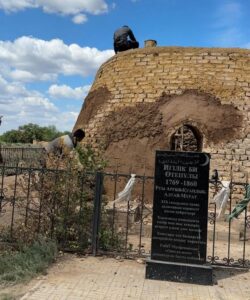A 150-year-old mausoleum, a medieval Golden Horde trade hub, and a Dzungarian-era temple are undergoing restoration in Kazakhstan’s Karagandy, Atyrau, and East Kazakhstan regions. The effort aims to preserve cultural identity, honour national history, and promote heritage tourism, reported Nagima Abuova of The Astana Times, citing Kazinform.
One of the key projects is the restoration of the Igilik Bi mausoleum, located near the village of Baitam in the Karagandy Region. Built between 1875 and 1880, the octagonal adobe structure with a dome was designated a monument of national historical and architectural significance in 2000 and placed under state protection, according to the regional akimat (local administration).
Over the decades, the mausoleum has been damaged by natural factors. Current restoration efforts focus on preserving its original architectural character while ensuring long-term structural stability.
Although no records of the original builders survive, the site holds deep cultural meaning. Igilik Bi, whose last name is originally Utepov, was a respected 19th-century figure in the Kareke-Altai rural district. He made significant contributions to education, coal mining, and public welfare for the Kazakh people. His legacy is also captured in the novel “Oyangan Olke” (The Awakened Land) by renowned writer Gabit Musrepov.
The Aktobe-Laeti archaeological site in the Atyrau Region will become an open-air museum. According to the Atyrau Region’s Center for the Study of Historical and Cultural Heritage, the 34.9-hectare site, located in the suburbs of Atyrau, has been protected by a regional government decree since April 2023.
“From the 13th to 15th centuries, the Aktobe-Laeti settlement was one of the flourishing cities of the Golden Horde in the Caspian lowlands. At that time, caravans from the cities of the Golden Horde, heading to Khorezm and Iran, passed through Aktobe-Laeti,” said Tolybai Dostybayev, the center’s director.
Dostybayev noted that the first archaeological excavations at this site began in 1965 under the direction of archaeologist Mikhail Mershchiev. In the 1970s and early 1980s, the Soviet Academy of Sciences conducted extensive excavations under the direction of archaeologist Lev Galkin. The site may have been damaged in the 14th century due to a rise in the Caspian Sea’s water level, and further disrupted in the 1950s by road construction and livestock grazing.
Excavations resumed in 2017 under the leadership of archaeologists Marat Kassenov and Amangeldy Zainov from the Khalel Dosmukhamedov Atyrau University.
“This Golden Horde-era settlement, which was an important center of craftsmanship, played a significant role in the development of the economy, culture, and ancient civilization of our country. As early as 2017, we discovered a production complex here. At that time, clay vessels and copper coins were also found. These ancient artifacts are not just relics of the past – they are the living history of our ancestors,” said Marat Kassenov.
“We should not associate the civilization of the nomads and Sarmatians solely with a nomadic lifestyle. They also reached a high level in craftsmanship, as confirmed by the findings made at Aktobe-Laeti,” he added.
The site features well-preserved foundations of residential buildings, and cultural layers measuring between 15 centimeters and 60 centimeters in depth. Archaeologists have uncovered workshops for the processing of metal, glass, and bone, as well as for the production of decorative items.
Recovered items include ceramic vessels, glass bracelets, beaded rings, and a gold coin from the 14th century. All artefacts are stored at the Atyrau Regional Museum of History and Local Lore.
Historical records and future vision for Aktobe-Laeti
The earliest written reference to Aktobe-Laeti appears in an 1861 report by Staff Captain A. Alekseev of the Ural Cossack Army’s cartographic division.
“Eight versts from the city of Guryev to the northeast, on the left bank of the Ural River, there is an elevated area with signs of buildings, which I examined and found fragments of pottery similar to those at Saray-Jadid, as well as copper coins that also resemble them. In addition, there are many human bones and various animal remains here,” wrote Alekseev.
“Such historical sites must be thoroughly studied. They are important for future generations as they are part of our national history. That is why we intend to turn this place into an open-air museum. According to the project, restoration will be carried out on an area of 1,890 square meters, excavated in 2018-2019. We also plan to create an archery area, build an administrative building, and improve the surrounding grounds,” said Dostybaev.
According to Mukhametkali Kipiev, director of the Atyrau Regional Museum, continued research may confirm a historical link between Aktobe-Laeti and the modern city of Atyrau.
“The meaning of the word ‘Laeti’ in its name remains unknown. Archaeologists suggest that the foundation of this settlement lies in a city of the Golden Horde. It is possible that this is indeed Aktobe-Laeti. There is also a theory that medieval settlements were once located on this site,” said Kipiev.
In the East Kazakhstan Region’s Ulan District, authorities are preparing to restore and promote the Ablaikit temple complex, one of the few remaining sites of the Dzungar civilization. The temple is located near the scenic group of five interconnected freshwater Sibin Lakes. It holds historical and archaeological value dating back to the 17th century.
“We invited Boris Shcherbakov, a well-known researcher who is very familiar with this place. A project was prepared with his participation, and work will begin soon,” said Lyaziza Kenzhetaeva, a deputy akim (mayor) of the Ulan district, during a regional press briefing.
According to her, the project will restore key architectural elements, landscape the surrounding area, and build a road from the first of the Sibin lakes to improve accessibility. A major focus will be on developing tourism infrastructure while preserving the site’s historical integrity.
Local authorities emphasise that the site is attracting foreign visitors, particularly tourists from China. In the future, organised tours may be introduced, giving an extra boost to the development of cultural tourism in the region.




